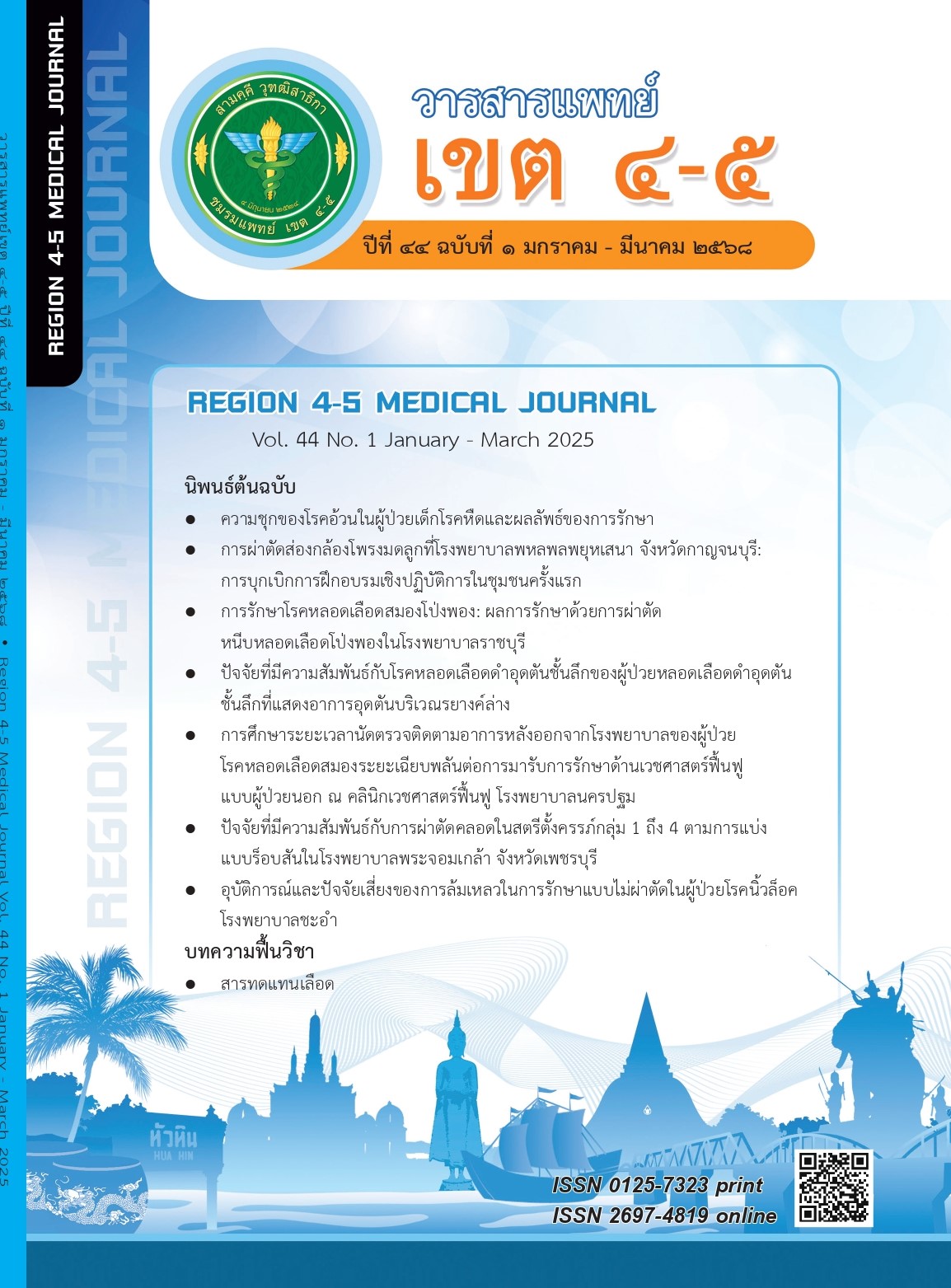ปัจจัยที่มีความสัมพันธ์กับโรคหลอดเลือดดำอุดตันชั้นลึกของผู้ป่วยหลอดเลือดดำอุดตันชั้นลึกที่แสดงอาการอุดตันบริเวณรยางค์ล่าง
คำสำคัญ:
โรคหลอดเลือดดำอุดตันชั้นลึก, อาการอุดตันบริเวณรยางค์ล่าง, ผู้ป่วยหลอดเลือดดำอุดตันชั้นลึกบทคัดย่อ
วัตถุประสงค์: เพื่อศึกษาปัจจัยที่มีความสัมพันธ์กับโรคหลอดเลือดดำอุดตันชั้นลึกของผู้ป่วยหลอดเลือดดำอุดตันชั้นลึกที่แสดงอาการอุดตันบริเวณรยางค์ส่วนล่าง
วิธีการศึกษา: การศึกษาเชิงพรรณนาแบบย้อนหลัง (retrospective descriptive study) เก็บข้อมูลจากเวชระเบียนผู้ป่วยที่เข้ารับการรักษา โรงพยาบาลบ้านโป่ง จังหวัดราชบุรี ตั้งแต่เดือนตุลาคม พ.ศ. 2561–กันยายน พ.ศ. 2567 จำนวน 177 ราย
ผลการศึกษา: กลุ่มตัวอย่างเป็นเพศหญิง ร้อยละ 73.4, มีอายุระหว่าง 61–80 ปี ร้อยละ 44.6, ดัชนีมวลกายปกติ ร้อยละ 33.3, ส่วนใหญ่ไม่ติดเตียง ร้อยละ 89.9, ไม่สูบบุหรี่ ร้อยละ 82.5, มีโรคประจำตัว ร้อยละ 58.2, ไม่เคยเข้ารับการผ่าตัด ร้อยละ 63.3, มีประวัติการบาดเจ็บโดยเฉพาะบริเวณขา/กระดูกสันหลัง ร้อยละ 18.6, ประวัติการรับประทานยาคุม ร้อยละ 9.6, ประวัติการเป็นโรคมะเร็ง/การได้รับเคมีบำบัดและการฉายแสง ร้อยละ 18.6, ตำแหน่งการเกิดภาวะหลอดเลือดอุดตันที่พบมากที่สุดคือ เส้นเลือดดำส่วนต้นขา ร้อยละ 83.6 โดยพบว่า ปัจจัยที่มีความสัมพันธ์กับโรคหลอดเลือดดำอุดตันชั้นลึกของผู้ป่วยหลอดเลือดดำอุดตันชั้นลึกที่แสดงอาการอุดตันบริเวณรยางค์ส่วนล่าง ได้แก่ อายุ (r = .057, p = .046); ดัชนีมวลกาย (r = .248, p = .047); ประวัติการเกิดซ้ำ (r = .098, p = .000); ประวัติการสูบบุหรี่ (r = .116, p = .036); ประวัติการรับประทานยาคุม (r = .245, p = . 001); ประวัติการเป็นโรคมะเร็ง/การได้รับเคมีบำบัดและการฉายแสง (r = .203, p = .020)
สรุป: ปัจจัยที่มีความสัมพันธ์กับโรคหลอดเลือดดำอุดตันชั้นลึกของผู้ป่วยหลอดเลือดดำอุดตันชั้นลึกที่แสดงอาการอุดตันบริเวณรยางค์ส่วนล่าง ได้แก่ อายุ ดัชนีมวลกาย ประวัติการเกิดซ้ำ ประวัติการสูบบุหรี่ ประวัติการรับประทานยาคุม และประวัติการเป็นโรคมะเร็ง/การได้รับเคมีบำบัดและการฉายแสง
เอกสารอ้างอิง
Stone J, Hangge P, Albadawi H, et al. Deep vein thrombosis: pathogenesis, diagnosis, and medical management. Cardiovasc Diagn Ther 2017;7(Suppl 3):S276–84. doi: 10.21037/cdt.2017.09.01
United States Center for Disease Control and Prevention. Venous thromboembolism (blood clots): data and statistics on venous thromboembolism [internet]. 2024 [cited 2024 November 16]; Available from: URL: https://www.cdc.gov/blood-clots/data-research/facts-stats/index.html
Mazzolai L, Aboyans V, Ageno W, et al. Diagnosis and
management of acute deep vein thrombosis: a joint consensus document from the
European society of cardiology working groups of aorta and peripheral vascular diseases and pulmonary circulation and right ventricular function. Eur Heart J 2018;39(47):4208–18. doi: 10.1093/eurheartj/ehx003
White RH. The epidemiology of venous thromboembolism. Circulation 2003;107(23 suppl 1):I4–8. doi: 10.1161/01.CIR.0000078468.11849.66.
Cushman M. Epidemiology and risk factors for venous thrombosis. Semin Hematol 2007;44(2):62–9. doi: 10.1053/j. seminhematol.2007.02.004.
Stein PD, Kayali F, Olson RE, et al. Pulmonary thromboembolism in Asians/Pacific Islanders in the United States: analysis of data from the National Hospital Discharge Survey and the United States Bureau of the Census. Am J Med 2004;116(7):435–42. doi: 10.1016/j.amjmed.2003.11.020.
Tsai AW, Cushman M, Rosamond WD, et al. Cardiovascular risk factors and venous thromboembolism incidence: the longitudinal investigation of thromboembolism etiology. Arch Intern Med 2002;162(10):1182–9. doi: 10.1001/archinte.162.10.1182.
Boddi M, Peris A. Deep vein thrombosis in intensive care. Adv Exp Med Biol 2017; 906:167–81. doi: 10.1007/5584_2016_114.
Ageno W, Becattini C, Brighton T, et al. Cardiovascular risk factors
and venous thromboembolism: a meta-analysis. Circulation 2008;117(1):93–102. doi: 10.1161/CIRCULATIONAHA.107.709204.
Minet C, Potton L, Bonadona A, et al. Venous thromboembolism in the ICU: main characteristics, diagnosis and thromboprophylaxis. Crit Care 2015;19(1):287. doi: 10.1186/s13054-015-1003-9
Ejaz A, Ahmed MM, Tasleem A, et al. Thromboprophylaxis in intensive care unit patients: a literature review. Cureus 2018;10(9):e3341. doi: 10.7759/cureus.3341.
Boonyawat K, Crowther MA. Venous thromboembolism prophylaxis in critically ill patients. Semin Thromb Hemost 2015;41(1):68–74. doi: 10.1055/s-0034-1398386.
Supparerk P, Monravee T, Suvit S, et al. Incidence and associated factors of deep vein thrombosis in Thai surgical ICU patients without chemoprophylaxis: one year study. J Med Assoc Thai 2015;98(5):472–8.
Scolaro JA, Taylor RM, Wigner NA. Venous thromboembolism in orthopedic trauma. J Am Acad Orthop Surg 2015;23(1):1–6. doi: 10.5435/JAAOS-23-01-1.
Nunno A, Li Y, Pieters TA, et al. Risk factors and associated complications of symptomatic venous thromboembolism in patients with craniotomy for meningioma. World Neurosurg 2019;122:e1505–10. doi: 10.1016/j.wneu.2018.11.091.
วรวิทย์ โชติวรางกูล. ผู้ป่วยหลอดเลือดดำส่วนลึกที่ขาอุดตันในโรงพยาบาลสวรรค์ประชารักษ์.
สวรรค์ประชารักษ์เวชสาร 2018;15(3):71–84.
Sermsathanasawaddi N, Thongrod R, Yakira K, et al. Prevalence of perioperative asymptomatic proximal deep vein thrombosis in Thai gynaecologic cancer patients. J Med Assoc Thai 2014;97(2):153–8.
พรทิพย์ สารีโส, เกศรินทร์ อุทริยะประสิทธิ์. การประยุกต์ใช้หลักฐานเชิงประจักษ์เพื่อป้องกันหลอดเลือดดำอุดกั้นในผู้ป่วยอายุรกรรม-ศัลยกรรม. วารสารพยาบาลศาสตร์ 2011;29(2):27–36.
Jeraq M, Cote DJ, Smith TR. Venous thromboembolism in brain tumor patients. Adv Exp Med Biol 2017;906:215–28. doi: 10.1007/5584_2016_117.
Huang Y, Ge H, Wang X, et al. Association between blood lipid levels and lower extremity deep venous thrombosis: a population-based cohort study. Clin Appl Thromb Hemost 2022;28:10760296221121282. doi: 10.1177/10760296221121282.
Stein PD, Beemath A, Olson RE. Obesity as a risk factor in venous thromboembolism. Am J Med 2005;118(9):978–80. doi: 10.1016/j.amjmed.2005.03.012.
Cushman M, Kuller LH, Prentice R, et al. Estrogen plus progestin and risk of venous thrombosis. JAMA 2004;292:1573–80. doi:10.1001/jama.292.13.1573
Waheed SM, Kudaravalli P, Hotwagner DT. Deep vein thrombosis . StatPearls [Internet]. 2023 [cited 2025 Jan 16]; Available from: URL: https://www.ncbi.nlm.nih.gov/books/NBK507708/
Vascular Vein Centers. The link between smoking and DVT [internet]. 2018 [cited 2024 November 16]. Available from: URL: https://www.bestveintreatment.com/blog/the-link-between-smoking-and-dvt
Piparva KG, Buch JG. Deep vein thrombosis in a woman taking oral combined contraceptive pills. J Pharmacol Pharmacother 2011;2(3):185–6. doi: 10.4103/0976-500X.83284.
van Hylckama Vlieg A, Helmerhorst FM, Vandenbroucke JP, et al. The venous thrombotic risk of oral contraceptives, effects of oestrogen dose and progestogen type: results of the MEGA case-control study. BMJ 2009;339:b2921. doi: 10.1136/bmj.b2921.
Blom JW, Vanderschoot JP, Oostindier MJ, et al. Incidence of venous thrombosis in a large cohort of 66,329 cancer patients: results of a record linkage study. J Thromb Haemost 2006;4(3):529–35. doi: 10.1111/j.1538-7836.2006.01804.x.
Blom JW, Doggen CJ, Osanto S, et al. Malignancies, prothrombotic mutations, and the risk of venous thrombosis. JAMA 2005;293:715–22. doi: 10.1001/jama.293.6.715.
ดาวน์โหลด
เผยแพร่แล้ว
รูปแบบการอ้างอิง
ฉบับ
ประเภทบทความ
สัญญาอนุญาต

อนุญาตภายใต้เงื่อนไข Creative Commons Attribution-NonCommercial-NoDerivatives 4.0 International License.
ลิขสิทธิ์บทความเป็นของผู้เขียนบทความ แต่หากผลงานของท่านได้รับการพิจารณาตีพิมพ์ลงวารสารแพทย์เขต 4-5 จะคงไว้ซึ่งสิทธิ์ในการตีพิมพ์ครั้งแรกด้วยเหตุที่บทความจะปรากฎในวารสารที่เข้าถึงได้ จึงอนุญาตให้นำบทความในวารสารไปใช้ประโยชน์ได้ในเชิงวิชาการโดยจำเป็นต้องมีการอ้างอิงถึงชื่อวารสารอย่างถูกต้อง แต่ไม่อนุญาตให้นำไปใช้ในเชิงพาณิชย์




